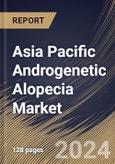The China market dominated the Asia Pacific Androgenetic Alopecia Market, By Country in 2022, and would continue to be a dominant market till 2030; thereby, achieving a market value of $364.8 Million by 2030. The Japan market is showcasing a CAGR of 8.3% during (2023 - 2030). Additionally, The India market would register a CAGR of 9.7% during (2023 - 2030).
With the availability of information online, consumers are more empowered to research and make informed decisions about their healthcare. The democratization of information enables individuals to explore various options, understand potential risks and benefits, and actively participate in discussions with healthcare providers. This sense of empowerment has led to a proactive approach in seeking and adopting androgenetic alopecia interventions. The adoption of surgical interventions, particularly hair transplantation techniques like Follicular Unit Transplantation (FUT) and Follicular Unit Extraction (FUE), is on the rise. These procedures involve the transplantation of healthy hair follicles from one part of the scalp to the balding areas, providing a permanent solution to androgenetic alopecia.
These are among the most widely adopted pharmaceutical products for androgenetic alopecia. Minoxidil, available as a topical solution, stimulates hair growth, while finasteride, an oral medication, inhibits the effects of the hormone dihydrotestosterone (DHT), a major contributor to hair loss in androgenetic alopecia. Low-level laser therapy (LLLT) devices, such as laser caps and helmets, are gaining adoption for their non-invasive approach to stimulating hair follicles and promoting hair growth. Platelet-rich plasma (PRP) injections involve using the patient’s plasma to stimulate hair follicles. This non-surgical option has seen increased adoption for its minimal invasiveness.
The Asia Pacific pharmaceutical industry may witness the introduction of new pharmaceuticals designed to treat androgenetic alopecia. The Asia Pacific region is experiencing a demographic shift with a rising aging population. It is often contribute with aging, and the growing number of elderly individuals contributes to an increased prevalence of hair loss, driving the demand for pharmaceutical interventions in Asia Pacific. Urbanization and changes in lifestyle patterns in the Asia Pacific region contribute to increased stress and lifestyle-related factors, known as contributors to hair loss in Asia Pacific. There is a heightened awareness of androgenetic alopecia and available pharmaceutical solutions in the Asia Pacific region. Therefore, due to the above-mentioned factors, the market will grow significantly in this region.
Based on Treatment, the market is segmented into Pharmaceuticals, and Devices. Based on Gender, the market is segmented into Male, and Female. Based on Sales Channel, the market is segmented into Prescriptions, and OTC. Based on End-use, the market is segmented into Dermatology Clinics, and Homecare Settings. Based on countries, the market is segmented into China, Japan, India, South Korea, Australia, Malaysia, and Rest of Asia Pacific.
List of Key Companies Profiled
- Cipla Limited
- Merck & Co., Inc.
- GlaxoSmithKline PLC (GSK)
- Sun Pharmaceuticals Industries Ltd.
- Dr.Reddy’s Laboratories Ltd.
- Aurobindo Pharma Limited
- Pfizer, Inc.
- Lutronic Co., Ltd.
- Viatris Inc.
- Eli Lilly and Company
Market Report Segmentation
By Treatment- Pharmaceuticals
- Devices
- Male
- Female
- Prescriptions
- OTC
- Dermatology Clinics
- Homecare Settings
- China
- Japan
- India
- South Korea
- Australia
- Malaysia
- Rest of Asia Pacific
Table of Contents
Companies Mentioned
- Cipla Limited
- Merck & Co., Inc.
- GlaxoSmithKline PLC (GSK)
- Sun Pharmaceuticals Industries Ltd.
- Dr. Reddy’s Laboratories Ltd.
- Aurobindo Pharma Limited
- Pfizer, Inc.
- Lutronic Co., Ltd.
- Viatris Inc.
- Eli Lilly and Company









